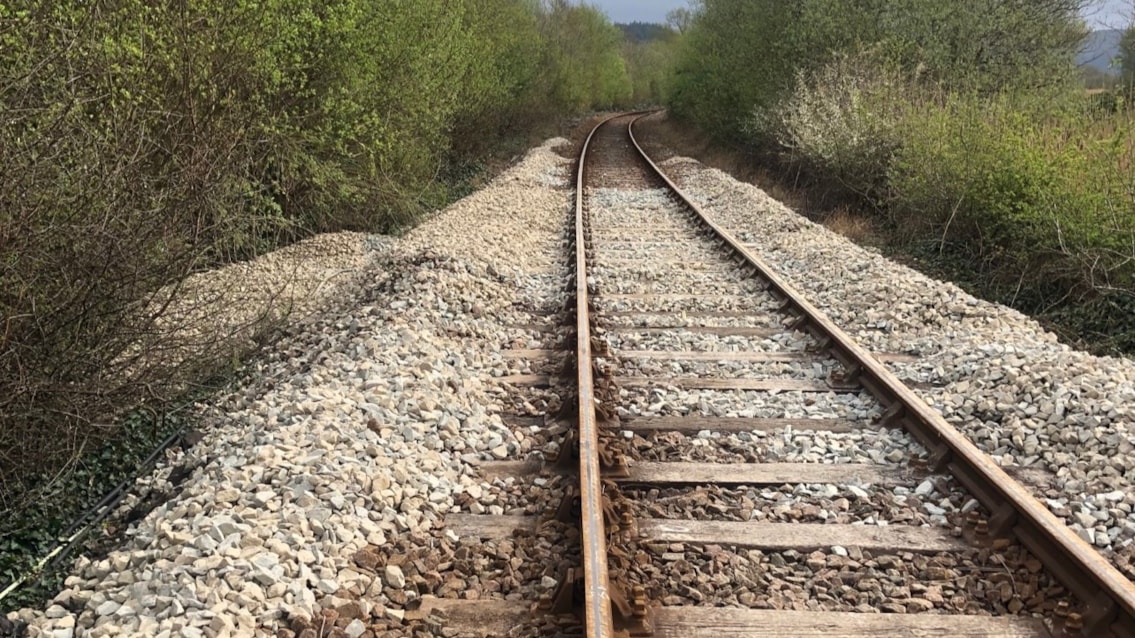Saturday 13 Apr 2024
Conwy Valley Line in North Wales reopens after emergency repairs
- Region & Route:
- Wales & Western
- | Wales & Western: Wales & Borders
Train services on the Conwy Valley Line in North Wales have resumed this morning (Saturday 13 April) following emergency repairs to flood damage.
The line was closed on Tuesday afternoon (9 April) when river flooding washed away ballast (the stones that support the track) near Dolgarrog station.
Network Rail engineers have since worked around the clock so the railway could reopen safely, installing more than 200 tonnes of new ballast.
The work was completed last night, with the line successfully tested this morning to allow Transport for Wales to resume services between Llandudno Junction and Blaenau Ffestiniog.
Rachel Heath, Network Rail Wales and Borders operations director, said: “I’d like to thank passengers for their patience while we carried out repairs to the Conwy Valley Line. I’d also like to thank our teams who worked tirelessly to plan and carry out the work, allowing the railway to reopen safely.
“While it is always disappointing to have to shut any line for these reasons, we are heartened by the fact the resilience work we completed in 2019 and 2020 allowed us to recover quickly from this week’s incident and reopen the line within four days.”
Marie Daly, Chief Customer and Culture Officer at TfW, said: “We’d like to thank our customers for their patience while our colleagues at Network Rail worked to repair the damage caused by the recent flooding.
“Customers can check for the latest travel information using the TfW website, our award-winning mobile app or via our social media channels.”
Notes to Editors
- Following storm damage in 2019, the line was closed for four months while Network Rail carried out work to repair six miles of track, two stations and eight level crossings.
- Further work in 2020 saw the line closed for seven months (largely during the COVID pandemic when trains were not running on the route) so Network Rail could install 16,000 tonnes of rock armour.
- The latest incident was 0.5 miles from the resilience work carried out in 2020. These works held firm and, had they not taken place, this latest flooding incident is likely to have closed the line for a period of up to four months.
Contact information
Passengers / community members
Network Rail national helpline
03457 11 41 41
Latest travel advice
Please visit National Rail Enquiries
Journalists
Steve Cotton
Media Relations Manager
steve.cotton2@networkrail.co.uk
About Network Rail
We own, operate and develop Britain's railway infrastructure; that's 20,000 miles of track, 30,000 bridges, tunnels and viaducts and the thousands of signals, level crossings and stations. We run 20 of the UK's largest stations while all the others, over 2,500, are run by the country's train operating companies.
Usually, there are almost five million journeys made in the UK and over 600 freight trains run on the network. People depend on Britain's railway for their daily commute, to visit friends and loved ones and to get them home safe every day. Our role is to deliver a safe and reliable railway, so we carefully manage and deliver thousands of projects every year that form part of the multi-billion pound Railway Upgrade Plan, to grow and expand the nation's railway network to respond to the tremendous growth and demand the railway has experienced - a doubling of passenger journeys over the past 20 years.
Follow us on Twitter: @networkrail
Visit our online newsroom: www.networkrailmediacentre.co.uk

